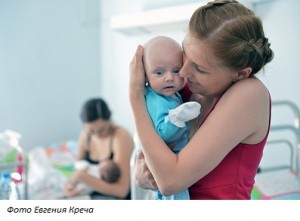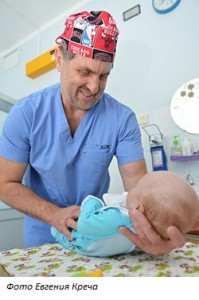Ilyusha and his good luck

Ilyusha, a month and a half, is finally at home. His Mom bursts the tears with difficulty: I can’t take my eyes off the son. I want to see him all the time, to be near him.
The child is wanted. Pregnancy was easy. Marina, the doctor herself, followed all the instructions of obstetrician-gynecologists, visited ultrasound procedure regularly. Terrible news was learned after the delivery in the intensive care unit (due to the weakness of labor, the doctors had to urgently perform cesarean section): Your son has a complex pathology: congenital diaphragmatic hernia, surgery is required.
With such a disease, the intestine or part of it, the spleen, sometimes the stomach, part of the colon is located in the chest. Children breathe only with one lung, but it does not fully function, because it is compressed by the heart and intestines. Auxiliary ventilation is needed after the birth.
Annually about 15 babies are born with such a disease in Belarus, in Kobrin for the first time. Ilya was urgently transported to the Brest Regional Children’s Hospital, and then to the Children’s Surgery National Applied Research Hospital.
Alexandr Makhlin, Deputy Clinical Director of the Children’s Surgery National Applied Research Hospital:
The boy came to us in a very serious condition: the hernia strongly squeezed the heart and lungs. We managed to operate the child only on the 9th day: thoracoscopy was performed. The intervention has been successful, the baby is slowly recovering, breathing on its own.
Thoracoscopy is well developed. It was used at the Children’s Surgery National Applied Research Hospital for the first time in Belarus in 2009.
Before such operations were performed cavitary and through the abdomen. A significant disadvantage is that repeated intervention, which is often required, is almost impossible to conduct. When accessing through the thorax, the abdomen remains untouched. 15 years ago the mortality rate among such patients reached 90%, today – isolated incident. Improvement of anesthesia and resuscitation care has also played a role. Children begin to be operated on the 4th-6th day after birth, so the forecasts have improved.
Ilyusha did without complications, although, I must admit, we had fears. But there was a hidden problem: 3 days after thoracoscopy, the phenomena of peritonitis were discovered – a consequence of an intrauterine infection. We performed one more operation: “washed” the tummy.
From the 7th day after the second intervention it became clear: the child was unable to eat. All food rushed back. At first, we suspected reflux disease. This disease is often found in combination with congenital hernia.
X-ray examination revealed that the stomach was twisted. Before the operation with the help of ultrasound we found that the spleen was guilty in the problems with digestion. It was in the pelvic cavity.
Alexander Svirsky, Head of the Department of Surgery of the Children’s Surgery National Applied Research Hospital, Candidate of Medicine, Associate Professor:

Normally, the spleen is fixed to the diaphragm and the stomach by ligaments. Our patient had a ligamentous apparatus with a very long vascular pedicle. The heavy spleen, having lowered, has bent a stomach like a jackknife. The child could not receive food in the traditional way (all these weeks he ate intravenous).
We had a new task: to open the stomach and fix the spleen in place.
Complexity is that the spleen in newborns (like the liver) can not be sewn. The organ capsule is so tender that there are ruptures and bleeding at the slightest stitching. Elimination is also not the best option, because it leads to a decrease in immunity and potential developing of lightning sepsis (transition from a healthy state to death sometimes takes only 24 hours in splenectomized).
We’ve got an experience (about 5 operations), when, we used a corpseal hard dura mater and wrapped an organ in it to protect it from loss of blood in cases of bleeding of the spleen.
So we sew a bag from a special pericardial plate, which is usually used by cardiac surgeons to correct heart defects. Than we loaded the spleen into this pouch, tied it and lined it around the rib. In addition, gastric gastropexy was performed: we fixed it in such a way that it could not be bent. Four days after the intervention, we began slowly to give the patient a mixture, he began to absorb it, and gain the weight.
A child with a wandering spleen is only met for the third time for the 30-years history of the Pediatric Surgical Hospital. We have encountered such a pathology for the first time in a newborn, we have never had a combination of this feature with diaphragmatic hernia …
“I know that to treat children is much more complicated than adults, because a baby cannot explain what he feels or show where it hurts,” says Marina Volosevich, the mother of Ilyusha. “While my son was in intensive care, I came to him, found out about his condition by phone. Day and night kind and caring medical staff is on duty with children. A deep bow to everyone who took care of my son and saved his life: Alexandr Makhlin, Alexandr Svirsky, all the medical staff of the Children’s Surgery National Applied Research Hospital. I express my gratitude to the President of our country, Alexandr Lukashenko, for his attention to the development of public healthcare. It’s good that there are such Hospitals in Belarus, where there are such doctors, equipment and where one can find assistance even with unusual cases.”
Taken from the site www.MedVestnik.by
